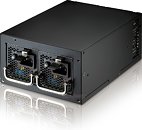- Joined
- Oct 9, 2007
- Messages
- 47,681 (7.42/day)
- Location
- Dublin, Ireland
| System Name | RBMK-1000 |
|---|---|
| Processor | AMD Ryzen 7 5700G |
| Motherboard | Gigabyte B550 AORUS Elite V2 |
| Cooling | DeepCool Gammax L240 V2 |
| Memory | 2x 16GB DDR4-3200 |
| Video Card(s) | Galax RTX 4070 Ti EX |
| Storage | Samsung 990 1TB |
| Display(s) | BenQ 1440p 60 Hz 27-inch |
| Case | Corsair Carbide 100R |
| Audio Device(s) | ASUS SupremeFX S1220A |
| Power Supply | Cooler Master MWE Gold 650W |
| Mouse | ASUS ROG Strix Impact |
| Keyboard | Gamdias Hermes E2 |
| Software | Windows 11 Pro |
Fortron's channel brand FSP is ready with a unique new redundant power supply for standard ATX desktops. The new Twins Series PSU is an ATX-size box that encloses two hot-swappable 500W server-grade PSUs, with internal circuitry that maintains redundancy. The PSU further interfaces with your OS, giving you control over redundancy, monitoring, and programmable alerts. The PSU is ideal for home-servers and workstations with <500W power draw. Each of the two included subunits features 40 mm server-grade fans. FSP plans to reveal more information at its 2016 Computex exhibit.

View at TechPowerUp Main Site

View at TechPowerUp Main Site
Last edited by a moderator:




